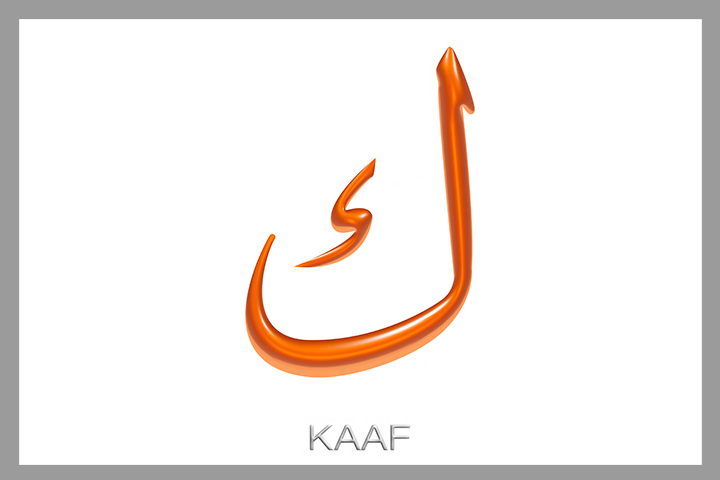The letter ك (Kaaf) is one of the most recognizable and easiest sounds for English speakers to master in the Arabic alphabet. Therefore, it acts as a friendly bridge between your native language and the new sounds of Arabic. Ultimately, this guide shows you everything about the kaaf arabic letter, from its unique shapes to its straightforward pronunciation.
ك (Kaaf) in Arabic: The Sound and Its Twin (Qaf)
The kaaf in arabic is the twenty-second letter of the alphabet. Although its sound is simple, its unique written forms are crucial to recognize.
How To Pronounce “ك”
To begin, the pronunciation of ك is very easy for English speakers, since it is a direct match to the English ‘K’ sound.
- Sound: Pronounced exactly like the ‘k’ in “kite” or “book.” It is a light, clear sound.
- Articulation: It is a velar stop, produced by pressing the back of the tongue against the soft palate (the back of the roof of your mouth) and releasing a puff of air.
- The Difference (ك vs ق): Crucially, do not confuse it with the letter Qaf (ق), because that letter is articulated deeper in the throat and produces a heavy, guttural sound. In fact, distinguishing these two sounds is key to proper Arabic pronunciation.
Dialectal Variation: The “Ch” Sound
Note: In some Gulf and Iraqi dialects, the feminine possessive suffix كِ (-ki(your f.)) often changes its sound to a ‘ch’ or ‘sh’ sound (like in “church” or “shake”). This sound change is specific to grammar and pronunciation, not the letter itself.
The Kaaf Arabic Letter: Shapes and Writing
Moving on, the kaaf arabic letter is known for having two distinct forms when written: its large final form and its simplified initial form.
| Position | Arabic Shape | Writing Detail |
|---|---|---|
| Isolated | ك | The large, final shape containing the inner S-shape (often called kaaf shaqīqah or a mini-Hamza). |
| Initial | كـ | A clear diagonal stroke followed by a horizontal connector. (The inner S-shape is never used here). |
| Medial | ـكـ | Connects on both sides. Visually, it typically looks like a sharp triangle or an inverted ‘V’ on the line. Furthermore, this medial shape ensures smooth text flow. |
| Final | ـك | Connects to the previous letter and closes, taking the full, large form with the inner S-shape. Export to Sheets |
Tip for Writing: Above all, memorize that the inner symbol (the S-shape) only appears when the ك is isolated or at the very end of a word. When it connects, consequently, the letter is reduced to a simple line structure (كـ or ـكـ).
ك with Vowels (Harakat)
The sound of ك remains consistent and clear regardless of the vowel that follows it. For instance, here is how it interacts with short and long vowels:
Short Vowels and Sukoon
| Vowel | Arabic Form | Transliteration | Example Word | English Meaning |
|---|---|---|---|---|
| Fatha | كَ | ka | كَلْب (kalb) | dog |
| كَلِمَة (kalimah) | word | |||
| Damma | كُ | ku | كُرَة (kurah) | ball |
| كُوب (kūb) | cup / glass | |||
| Kasra | كِ | ki | كِتَاب (kitāb) | book |
| كَنِيسَة (kanīsah) | church | |||
| Sukoon | كْ | k | مَكْتَب (maktab) | office / desk |
| مُلْك (mulk) | ownership / kingdom |
Long Vowels
| Long Vowel | Arabic Form | Example Word | English Meaning |
|---|---|---|---|
| Alif | كَا | كَانَ (kāna) | he was |
| كَاذِب (kādhib) | liar | ||
| Waw | كُو | كُوخ (kookh) | hut |
| كوب (koob) | cup / glass | ||
| Yaa | كِي | كيس (kees) | big |
| سِكِّين (sikkeen) | knife |
Common Words Featuring ك (More Examples)
In summary, practice these common arabic words with ك to integrate the Kaaf sound into your vocabulary: Specifically, focusing on high-frequency words will accelerate your retention.
- book – كِتَاب (kitāb)
- dog – كَلْب (kalb)
- chair – كُرْسِي (kursī)
- all / every – كُلّ (kull)
- how much / how many – كَمْ (kam)
- he broke – كَسَرَ (kasara)
- word – كَلِمَة (kalimah)
- king – مَلِك (malik)
- fish – سَمَك (samak)
- library – مَكْتَبَة (maktabah)
- thank you – شُكْراً (shukran)
- disaster – كَارِثَة (kārithah)
Conclusion
The Kaaf arabic letter is one of the quickest wins you can achieve in the Arabic alphabet! Since its sound is so similar to English, you can focus your energy on mastering its four distinct shapes. With consistent writing practice, therefore, you will confidently use the ك sound and effortlessly read hundreds of new Arabic words. Finally, to accelerate your progress and get targeted practice, consider using Kaleela App. Keep practicing, and enjoy your journey to fluency!



